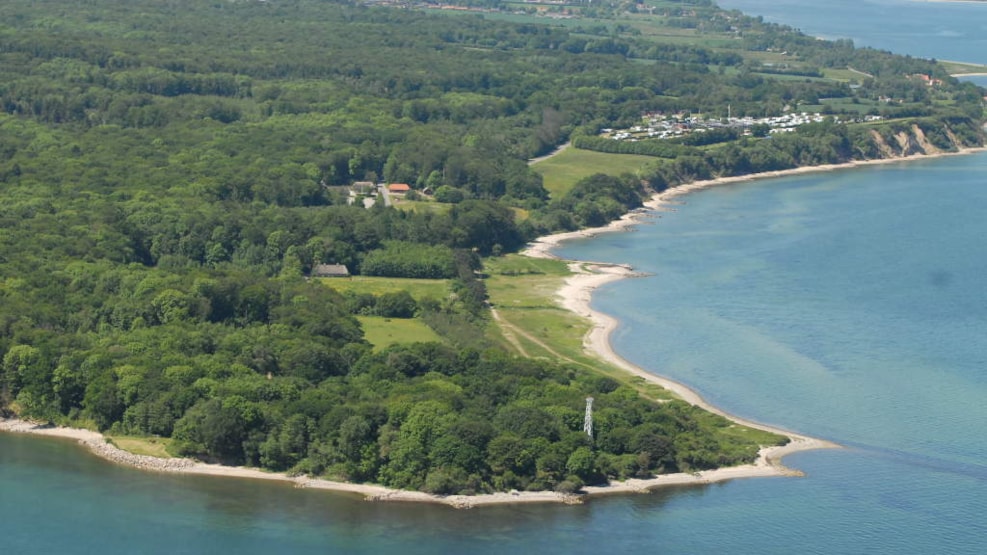
Guided tour of Trelde Næs
Go for a guided tour in the forests of Trelde Næs.
Trelde Næs is home to fantastic, beautiful nature with forests, steep clay slopes, meadows and a nice Blue Flag beach. The area is perfect for nature lovers.
15 unique nature sites, stretching from Skagen to Bornholm, form Denmark's Nature canon. One of them is right by the Little Belt ...
Geologically speaking, the area of Trelde Næs is unique. In the great 30 metre high clay slopes facing Vejle Fjord you can see clearly defined layers and sediments which date back more than 50 million years. The layers were created through no less than three ice ages and one interglacial period which brought the giant ice masses to a brief halt 400.000 years ago. Trelde Næs is also a good spot for finding fossils. The area has been appointed national, geological area of interest, and for good reason.
Along the Little Belt side of the ness, is a 6 km long untouched coastline with dramatic landslide formations. It is the longest and most remarkable of its kind in Denmark. The clay here, was once the bottom of an ocean, covering the northwestern part of Europe some 55 million years ago. One of the fossil types that can be found in the clay is shark teeth, from sharks that roamed the ocean millions of years ago.
The Danish society for Nature Conservation has ranked the Trelde forests as one the most biodiverse forest areas in Denmark. Trelde Næs therefore has a unique flora and fauna. If you are interested in mushroom hunting Trelde Næs is one of Jutland's best hunting fields. You may also come across the rare marsh orchid, which is only found in a few other spots in Denmark.
The tip of Trelde Næs was purchased by Fredericia Municipality in 1966 and was made a protected area. But the history of Trelde Næs is not entirely peaceful.
I early medieval times the lawless Count Trolle known as the King of the Ness roamed the area. During the 14th-15th century Trelde Næs belonged to the Crown's estates. Later Trelde Næs was object of much dispute between local lords and landowners who all wanted it. They were especially interested in the rights to the exceptional amount of herring in the waters by Trelde Næs.
In 1657 the area was occupied by Swedish soldiers who burned down all the farmhouses. Luckily the farmers had escaped into the Trelde forests in time. But they were forced to stay in hiding living in caves in the forests for more than a year.
In 1919 Trelde Næs was bought by business owner Harald Plum. Trelde Næs was used a summer retreat for mr. Plum's employees. Plum went bankrupt in 1923 and took his own life in 1929. By then, Trelde Næs was a public retreat with a summer time pension and a restaurant.
In 1930 Trelde Næs was sold again. It was then owned for years by Ane Ryholt who became known as the Queen of the Ness. Ane Ryholt was a headstrong character who guarded her personal life so much, that she eventually closed off Trelde Næs to the public and had gates and barbed wire fences installed around the estate. There were rumours that Ane kept guard dogs and sometimes threatened trespassers with a hunting rifle. Others claim she was kind and helpful as long as her privacy was respected. Ane Ryholt was in charge of a number of successful restaurants in Copenhagen and Trelde Næs was initially her summer residence. Later she moved permanently to her beloved estate and lived there until she died. She had sold the property a few years prior to her death, but the sale was conditioned by her right to stay until she died. Her ashes were spread on the lawn by the main house Troldehuset and a few years later the municipality placed a bust to mark her final resting place.
Today the beautiful area is open to the public. Troldehuset (the Troll House) is used mainly for school trips. The bus 6 stops at the parking lot right by the forest. From the bus stop there is easy access to the beach. You can acquire a brochure about Trelde Næs at the library in Fredericia.
At the Nature Centre at Trelde Næs Beach you can borrow free equipment for activities like crab-fishing, bonfires etc. The Nature Centre is open daily.
April-September 8am-9pm
October-March 10am-5pm
The centre also has a public lavatory. The restrooms at the Nature center are open all year round, but can be closed down during the winter if there is a risk of freezing pipes. The restroom for the handicapped is located by the old farm building is open all year round.